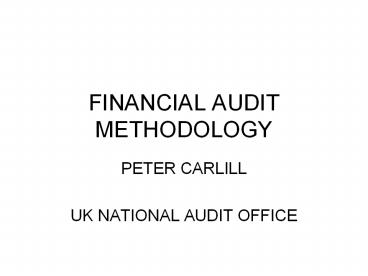FINANCIAL AUDIT METHODOLOGY - PowerPoint PPT Presentation
1 / 29
Title:
FINANCIAL AUDIT METHODOLOGY
Description:
Advice and guidance. PERFORMANCE AUDIT. How well Government policy is delivered. In particular: ... UNDERSTANDING THE BUSINESS. AUDITING STANDARD ... – PowerPoint PPT presentation
Number of Views:384
Avg rating:3.0/5.0
Title: FINANCIAL AUDIT METHODOLOGY
1
FINANCIAL AUDIT METHODOLOGY
- PETER CARLILL
- UK NATIONAL AUDIT OFFICE
2
ROLE OF NAO
- To provide independent information, assurance and
advice to Parliament on the use of public
resources - To help promote better financial management and
value for money
Our role
3
BODIES AUDITED
- CAG audits 600 financial statements covering
456 billion - Revenue of 337 billion
- Assets worth 203 billion
- Long term\liabilities of 37 billion
4
FINANCIAL AUDIT
- Audit Opinions
- Reports on Accounts
- Advice and guidance
5
PERFORMANCE AUDIT
- How well Government policy is delivered
- In particular
- Economy
- Efficiency
- Effectiveness
6
IMPACT
- Savings of over 8 every 1 spent by the NAO
- 1.4 BILLION saved over the last three years
- Over 90 PER CENT of PAC recommendations accepted
7
WHY HAVE A METHODOLOGY?
- Ensures Auditing Standards are applied
- Ensures consistency across the NAO (600
accounts) - Helps achieve a quantifiable level of assurance
(95 confidence level)
8
UNDERSTANDING THE BUSINESS
- AUDITING STANDARD
- In performing an audit of financial statements,
the auditor should have or obtain a knowledge of
the business sufficient to enable the auditor to
identify and understand the events, transactions
and practices that, in the auditors judgement,
may have a significant effect on the financial
statements.
9
UNDERSTANDING THE BUSINESS
- THREE AREAS TO CONSIDER
- Ministrys external environment
- Legislative framework
- Overall control environment within the Ministry
10
UNDERSTANDING THE BUSINESS
- AUDITING STANDARD
- The auditor should apply analytical procedures at
the planning stage to assist in understanding the
business and in identifying areas of potential
risk.
11
MATERIALITY
- AUDITING STANDARD
- Materiality should be considered by the auditor
when a) determining the nature, timing and
extent of audit procedures and b) evaluating the
effect of misstatements
12
MATERIALITY
- An audit needs to be planned and conducted so as
to provide reasonable assurance that the
financial statements are free from material
misstatement. - A matter is considered material if its omission,
concealment or misstatement could influence the
decisions of users of the financial statements
that were taken on the basis of the financial
statements.
13
MATERIALITY
- Usually a percentage (0.5 - 2) of
- Gross Assets
- Gross Expenditure
- Income
- Or, if applicable
- Profit (5-10)
14
MATERIALITY
- BUT
- Some items can be material because of their
sensitivity or by their context, even though they
may be small in value.
15
USE OF MATERIALITY
- Determines our audit approach to different
account areas - Helps us conclude on the extent of errors found
16
IDENTIFY MATERIAL RISKS
- Normal risk is present where transactions are
systematically processed, where the management
and control environment is good and where the
nature of the transactions themselves does not
lead to an increased risk of error. In case of
normal risk we can reduce the scope of audit
procedures - High risk is present in any account area where
the above characteristics do not apply. In case
of high risk, we take all the assurance we
require from substantive and controls testing.
17
RISKS
- ENTITY RISK
- ACCOUNT AREA RISK
18
RISKS
- Plot on the Risk Mapping Diagram
- 1. Computer crash leading to loss of all
accounting records - 2. Failure to estimate useful lives of PCs
leading to incorrect depreciation charges - 3. Risk of error in social security payments
because of highly complex regulations and
frequent changes of staff (Ministrys only
activity)
19
AREAS OF HIGH RISK
- DETERMINE MINISTRYS RESPONSE TO THE RISK (IN
TERMS OF ADDITIONAL CONTROLS OR SUPERVISION) - ASSESS THE RESIDUAL RISK AND AUDIT PROCEDURES
PROPOSED IN RESPONSE
20
The Decision Tree The Decision Tree provides a
framework to determine the audit procedures to be
used for each area of the account. The starting
point is our assessment of risk for the entity as
a whole and for individual account areas. Where
we have identified risks of material misstatement
we should look to test controls that have been
identified as mitigating the risks. Where we have
identified no risks of material misstatement we
should still look to test controls relevant to
the account area to provide the majority of audit
assurance. Beyond controls testing the balance
of assurance will come from substantive
procedures, including analytical procedures
(APs). If the account area/balance being
audited is not material it may be sufficient to
rely on an overall review of outtum only, without
testing controls.
9
AUDIT PROCEDURESCONCEPT AND DECISION TREE
21
UNDERTAKING THE AUDIT
- ANALYTICAL PROCEDURES
- RELINCE ON OTHERS
- CONTROLS TESTING
- TRANSACTION TESTING
22
ANALTYCIAL PROCEDURES
- COMPARATIVE
- PREDICTIVE TEST/MODELLING
23
RELIANCE
- INTERNAL AUDIT
- OTHER AUDITORS
- OTHER SPECIALISTS (eg BUILDING VALUATIONS)
24
ASSURANCE FROM CONTROLS
- AUDITING STANDARDS
- The auditor, in determining the extent and scope
of the audit, should study and evaluate the
reliability of internal controls. - The auditor should obtain an understanding of the
accounting and internal control systems
sufficient to plan the audit and develop an
effective audit approach.
25
CONTROLS
- HIGH LEVEL controls are those which affect gt 1
transaction. For example - Reconciliations
- Regular monitoring
- Exception reports
26
CONTROLS
- Assurance through
- Re-performance
- Examination
- Enquiry
- Observation
27
TRANSACTION TESTING
- Transaction testing is expensive, therefore use
other methods first to reduce the numbers
required. - Can use
- Statistical sampling
- Stratified sampling
- Judgemental sampling
- But beware of sample sizes too low or too high
28
EVALUATE RESULTS
- Errors lt materiality
- Errorsgt materiality
29
REPORT RESULTS































